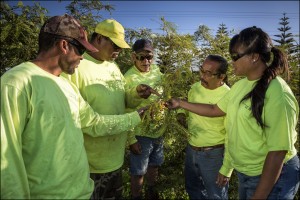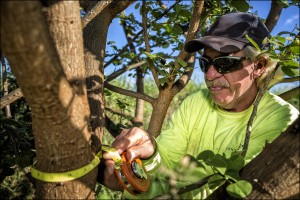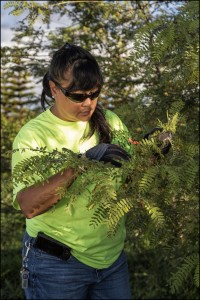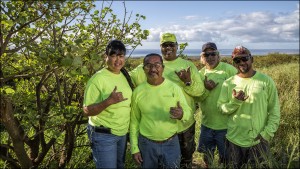Monsanto’s Molokaʻi Achieves Wildlife Habitat Council Certification

Pictured left to right: Monsanto Molokaʻi’s Freddie Maniago, Chad Tangonan, Kenneth Kaai, Patrick Kansana, and Kali Arce document flowers and seeds of the ʻohai (Sesbania arborea) plant, an endangered species planted on the farm as part of the company’s ongoing conservation practices efforts in building back rare and declining habitats.
Monsanto Hawaiʻi has announced that it’s Molokaʻi farm has become the first company in Hawaiʻi to achieve “Wildlife at Work” certification by the nonprofit Wildlife Habitat Council.
WHC is made up of a group of corporations, conservation organizations, and individuals dedicated to promoting and certifying habitat conservation and management on corporate lands through partnerships and education.
Company representatives say participation in WHC’s Conservation Certification program has enabled Monsanto to implement a wildlife management program.
Conservation practices in place at the company’s Molokaʻi farm include: planting vegetative cover on fallow lands to prevent soil loss; performing contour tillage to increase water infiltration; performing deep tillage to ensure farm lands remains healthy and productive; installing storm diversions to direct water away from fields; documenting wildlife species sighted on the farm; and planting permanent vegetation around perimeter of fields for windbreaks.

Kenneth Kaai, (a conservation team member) at Monsanto Molokaʻi, takes basal measurement on an ʻohai (Sesbania arborea) plant, an endangered native species, to document its growth.
This year alone, Monsanto reports that employees planted nearly 1,850 native trees, shrubs and understory species to protect 478 acres of farmland, about one-third of the total 2,200 acres.
The plantings include 11 different native or endangered plants including koa, milo and ʻohai.
The site will also serve as an outdoor educational classroom for people to learn about native Hawaiian plants.
“As part of our corporate environmental stewardship, we have strengthened our company’s goal of doubling crop yields using fewer resources such as land, water, and energy per unit produced,” said Kali Arce, conservation lead for Monsanto Molokaʻi.

Kali Arce, conservation lead at Monsanto Molokaʻi, documents an ʻohai (Sesbania arborea) plant, an endangered specie and one of nearly 1,850 native trees, shrubs and understory species planted as part of their conservation efforts in building back rare and declining habitats.
“We are focused on continuing to develop better seeds and improved on-farm practices that enable farmers to better manage weeds, pests, and environmental stresses; and we are proud to make these tools of innovation available to millions of farmers around the world,” said Arce in a company press release.
“Monsanto Hawaiʻi is honored to be recognized by the Wildlife Habitat Council for our conservation practices, and we’re very proud of the hard work and tremendous effort by our dedicated employees to achieve this certification,” said Ray Foster, Monsanto’s Molokaʻi site manager.
“The application process was very extensive, including planning, developing data sheets and maps, documenting the work performed, and training. We could not have done it without the commitment and passion of our Monsanto team,” said Foster.
Certification of Monsanto’s Molokaʻi farm will run through 2017.
Since 1988, WHC has certified more than 1,000 habitat enhancement and conservation education programs worldwide.
Monsanto produces seeds for fruits, vegetables and key crops – such as corn, soybeans, and cotton – that company representatives say help farmers have better harvests while using water and other important resources more efficiently.

Members of Monsanto Molokaʻi’s conservation team (pictured left to right): Kali Arce, Patrick Kansana, Chad Tangonan (behind Pat), Kenneth Kaai, Freddie Manaigo.
“We work to find sustainable solutions for soil health, help farmers use data to improve farming practices and conserve natural resources, and provide crop protection products to minimize damage from pests and disease,” company representatives said in a press release.
The company collaborates and has established partnerships with farmers, researchers, nonprofit organizations and universities.










